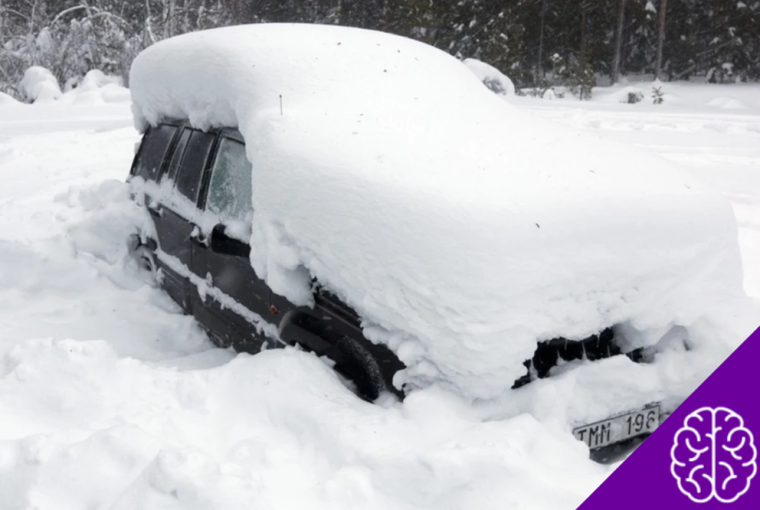When we think of survival stories, tales of resilience and human tenacity often come to mind. One such story is that of Peter Skyllberg, a Swedish man who defied all odds to survive being buried in snow, trapped inside his car for 60 days.
His incredible experience in the harsh, frozen conditions of Sweden offers valuable insights not only into human survival but also the phenomena and science that made it possible.
Trapped by Nature’s Fury
Imagine driving down a snowy road in Sweden and getting caught in an intense snowstorm with temperatures plummeting to -30°C. Unfortunately, for Peter Skyllberg, this was not just a scene from a movie but the grim reality he faced on December 19, 2011.
Skyllberg’s car became completely covered in snow near the city of Umeå in northeastern Sweden, rendering any attempt to move forward impossible.
For two long months, from December to February, he was cut off from the outside world, relying entirely on his resilience and the environment inside his snow-covered car to stay alive.
It wasn’t until February 17, 2012, that his car was accidentally discovered by two snowmobilers. Assuming the vehicle was abandoned, they cleared the snow from the windshield, only to find Skyllberg alive and moving faintly inside. This discovery sparked both amazement and countless questions.
Surviving Without Food or Heat
At the time of his rescue, Peter Skyllberg was in poor condition and could only speak a few words. Despite having no proper food for weeks, his survival was aided by a few key factors:
1. The “Igloo Effect”
Medical experts believe one critical aspect of Skyllberg’s survival was the “igloo effect.” A snow-covered car acts like an insulation chamber, trapping heat and creating a significantly warmer environment inside compared to the harsh cold outside. This effect provided just enough warmth to prevent fatal hypothermia.
2. Body Metabolism
Even after his food supply ran out, Peter’s body kept generating heat through a slowed metabolism. By conserving energy and remaining as still as possible for most of the time, he was able to withstand his grueling confinement.
3. Hydration from Melted Snow
Hydration is an essential component of survival, especially in freezing conditions where dehydration can set in quickly. Skyllberg reportedly melted snow for water, which kept his body functional despite the lack of food.
4. Cigarettes for Warmth
While somewhat controversial, reports suggest that Skyllberg used cigarettes to generate heat, with the warmth of the smoke helping to stabilize his body temperature.
While nicotine is known to be a vasoconstrictor that can reduce body heat, the small bursts of warmth from smoking may have had some role in his limited survival.
The Unanswered Questions
Skyllberg’s story raised more questions than answers. Some doubted whether his tale was entirely accurate.
Critics pointed out that nicotine can actually lower body temperature and disputed its role in his survival. Additionally, his financial troubles, including debts totaling €150,000, led some to speculate whether the entire situation was a setup or the result of despair.
Nevertheless, medical experts and survivalists remain intrigued by how Skyllberg endured extreme conditions without any specialized training or equipment. His case continues to spark debates within the scientific and survivalist communities.
Lessons from an Unbelievable Story
Peter Skyllberg’s story serves not just as a testament to human willpower but also as a scientific marvel. Here are a few key takeaways from his experience:
1. The Importance of Shelter
If faced with extreme weather, finding or creating a shelter is critical. Even a buried car, as demonstrated by Skyllberg, can serve as a barrier against the most hostile natural conditions.
2. Conserving Energy
Remaining still and conserving energy is crucial when resources are limited. Avoiding unnecessary movement and staying calm can help maximize your survival chances.
3. The Role of Psychological Resilience
While physical endurance is critical, mental resilience cannot be overlooked. The isolation and psychological toll of being trapped for 60 days could have easily led to despair, but Skyllberg’s composure kept him alive.
4. Preparation and Awareness
This case underscores the importance of preparing for emergencies when traveling in extreme conditions. Carrying provisions such as non-perishable food, water, a first-aid kit, and thermal blankets in your vehicle could save your life in unforeseen scenarios.
Could You Survive in Similar Conditions?
Skyllberg’s story leaves us marveling at the resilience of the human body and soul. His survival for 60 days under a thick layer of snow embodies the unpredictable and extraordinary forces of nature and human adaptability.
If you’re curious about other fascinating survival stories or want practical advice on preparing for harsh environments, check out our related articles and guides. They might just give you the tools to thrive when the odds are stacked against you!


